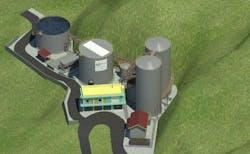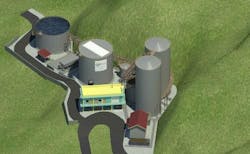GUATAMELA, JAN 17, 2019 -- Cervecería Centro Americana (CCA), a brewery located in Guatemala, is enhancing its environmental performance by using Global Water & Energy (GWE) technologies to convert wastewater into biogas while achieving effluent quality improvements of 97% in organic matter removal.
The brewery based in Guatemala City will treat its wastewater with a combination of GWE technologies in order to remove contaminants and generate green energy (or biogas), which could be used to power boilers, or be sold back to the grid for a profit.
GWE – which has recently rebranded from Global Water Engineering to reflect a growing focus on turning wastewater into green energy – states that waste-to-energy plants, of which the company has installed more than 400 in 62 countries, typically pay for themselves within 2-5 years and afterward continue to generate profit, while reducing fossil fuel dependence and carbon footprints of environmentally minded companies like CCA.
Global Water & Energy, formerly known as Global Water Engineering – headed by Chairman and CEO Jean-Pierre Ombregt – has recently rebranded to better reflect its growing emphasis on not only attaining wastewater quality improvements of up to 99 percent removal efficiency by anaerobic solutions, but also by increasingly implementing solutions on the organic waste streams in order to produce biogas, resulting in very attractive ROI.
"In addition to the ongoing financial benefit and short ROI of the new wastewater treatment plant and its green energy generating potential, the compact plant also utilizes existing space within the brewery, which means that no extra land will need to be purchased to deal with wastewater," says Mr. Ombregt.
"CCA is clearly thinking about the future, and these waste-to-energy technologies will help them meet sustainability initiatives and simultaneously minimize any negative effects on the environment," he said.
GWE's new wastewater treatment system is designed to remove approximately 97% COD, or Chemical Oxygen Demand – a measure of the organic content in the water. It will produce up to 4,800 Nm³/d of biogas at 76% methane content, which is equivalent to more than 3,200 kg heavy fuel oil/day. This heavy fuel oil is worth approximately $US500,000 a year. (This assumes a plant running 330 days a year at full capacity and a Heavy Fuel Oil, HFO, price of US 0.46c a liter.)
"CCA has many choices in order to reuse the biogas, but typical uses that benefit our customers in breweries, food processing, and other industries include Combined Heat and Power (CHP) units or other direct combustion systems such as boilers, turbines, or fuel cells. Where these options aren't available, companies often opt to generate green energy and sell it back to the grid for a profit," says Mr. Ombregt.
Wastewater Treatment Process
CCA's new wastewater treatment plant is designed to remove contaminants in the water, control odors and turn wastewater into biogas. It uses four major GWE technologies:
A SUPERSEP™-DF downflow solids separator, which provides efficient counter-current sludge separation, combined with co-current sludge evacuation. It is ideal for processing fragile organic sludge flocs. SUPERSEP™-DF is designed to incorporate multiple cleaning possibilities during operation, including the backwash of individual rows of modules (manual or automated) and the removal of individual lamella modules for cleaning.
An ANUBIX™-T Expanded Granular Sludge Bed, which is ideally suited to medium-to-high strength wastewaters, with COD values of up to 25,000 mg/l. ANUBIX™-T uses anaerobic purification to break down organic compounds and generate biogas.
GWE's ANUBIX™-T has a smaller footprint than other anaerobic technologies and operating interruptions are minimized due to the absence of moving parts inside the reactor.
A FLOTOX™ system, which incorporates a Moving Bed Biofilm Reactor (MBBR) and a SUPERFLOT™ solids separation system to polish the effluent aerobically from the ANUBIX™-T reactor.
Sludge separation will take place in the SUPERFLOT™- AIR, a Dissolved Air Flotation (DAF) unit, instead of a clarifier. This will result in a more compact solids separation system, thus considerably reducing the footprint compared to a conventional clarifier. Sludge from the SUPERFLOT™ unit will be thickened, so the dewatering system will be even more economical and compact.
An ODORIX™ Biofilter, which controls the odor and improves the working environment of the wastewater treatment plant by efficient degradation of the odorous compounds, organic acids, and hydrogen sulfide. The filter features a robust design and uses corrosion-free materials to optimize its operating life.



